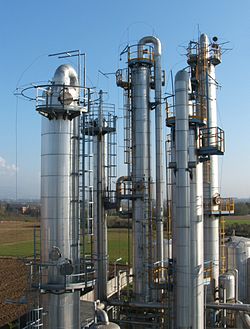

Composition of dry atmospheric air

Without oxygen we would die in a matter of minutes. Many people at work and sometimes at home use oxygen gas in cylinders.
Oxygen gas is the second most common component of the Earth's atmosphere, taking up 20.8% of its volume and 23.1% of its mass (some 1015 tonnes).
Uptake of Oxygen (O2 ) from the Air is the essential purpose of respiration, so oxygen supplementation is used in medicine. Treatment not only increases oxygen levels in the patient's blood, but has the secondary effect of decreasing resistance to blood flow in many types of diseased lungs, easing work load on the heart. Oxygen therapy is used to treat emphysema, pneumonia, some heart disorders (congestive heart failure), some disorders that cause increased pulmonary artery pressure, and any disease that impairs the body's ability to take up and use gaseous oxygen.
Treatments are flexible enough to be used in hospitals, the patient's home, or increasingly by portable devices. Oxygen tents were once commonly used in oxygen supplementation, but have since been replaced mostly by the use of oxygen masks or nasal cannulas
History of
Oxygen separation from Air
By the late 19th century scientists realized that Air could be liquefied, and its components isolated, by compressing and cooling it.
Oxygen was liquified in stable state for the first time on March 29, 1883 by Polish scientists from Jagiellonian University, Zygmunt Wróblewski and Karol Olszewsk
In 1891 Scottish chemist James Dewar was able to produce enough liquid oxygen to study. The first commercially viable process for producing liquid oxygen was independently developed in 1895 by German engineer Carl von Linde and British engineer William Hampson. Both men lowered the temperature of air until it liquefied and then distilled the component gases by boiling them off one at a time and capturing them.
Two major methods are employed to produce 100 million tonnes of O2 extracted from air for consumptions annually. The most common method is to fractionally distill liquefied air into its various components, with N2 distilling as a vapor while O2 is left as a liquid.

Industrial Fractional Distillation Columns
Fractional distillation is the most common form of separation technology used in air separation, producing liquid oxygen, liquid nitrogen, and highly concentrated argon.
Fractional distillation is also used in petroleum refineries, petrochemical and chemical plants, natural gas processing and cryogenic air separation plants.
In most cases, the distillation is operated at a continuous steady state. New feed is always being added to the distillation column and products are always being removed. Unless the process is disturbed due to changes in feed, heat, ambient temperature, or condensing, the amount of feed being added and the amount of product being removed are normally equal. This is known as continuous, steady-state fractional distillation.
Industrial fractional distillation is typically performed in large, vertical cylindrical columns known as "distillation or fractionation towers" or "distillation columns" with diameters ranging from about 65 centimeters to 6 meters and heights ranging from about 6 meters to 60 meters or more. The distillation towers have liquid outlets at intervals up the column which allow for the withdrawal of different fractions or products having different boiling points or boiling ranges. By increasing the temperature of the product inside the columns, the different hydrocarbons are separated. The "lightest" products (those with the lowest boiling point) exit from the top of the columns and the "heaviest" products (those with the highest boiling point) exit from the bottom of the column.

Air Separation Unit (ASU)
An air separation plant separates atmospheric air into its primary components, typically nitrogen and oxygen, and sometimes also argon and other rare inert gases.There are various technologies that are used for the separation process, the most common is via cryogenic distillation. This process was pioneered by Dr. Carl von Linde in the early 20th century and is still used today to produce high purity gases. The cryogenic separation process requires a very tight integration of heat exchangers and separation columns to obtain a good efficiency and all the energy for refrigeration is provided by the compression of the air at the inlet of the unit. In addition to the cryogenic distillation method there are other methods such as Membrane, Pressure Swing Adsorption (PSA) and Vacuum Pressure Swing
Adsorption (VPSA), which are typically used to separate a single component from ordinary air. Production of high purity oxygen, nitrogen, and argon as used for Semiconductor device fabrication requires cryogenic distillation, though. Similarly, the only viable sources of the rare gases neon, krypton, and xenon is the distillation of air using at least two distillation columns. Cryogenic ASU's are built to provide nitrogen and/or oxygen and often co-produce argon where liquid products (Liquid nitrogen "LIN", Liquid oxygen "LOX", and Liquid argon "LAR") can only be produced if sufficient refrigeration is provided for in the design.